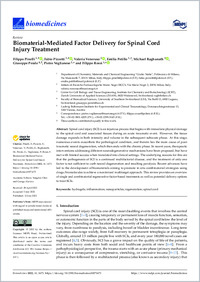Biomaterial-mediated factor delivery for spinal cord injury treatment
- Pinelli, Filippo Department of Chemistry, Materials and Chemical Engineering “Giulio Natta”, Politecnico di Milano, Italy
- Pizzetti, Fabio Department of Chemistry, Materials and Chemical Engineering “Giulio Natta”, Politecnico di Milano, Italy
- Veneruso, Valeria Istituto di Ricerche Farmacologiche Mario Negri IRCCS, Milan, Italy
- Petillo, Emilia Department of Chemistry, Materials and Chemical Engineering “Giulio Natta”, Politecnico di Milano, Italy - Istituto di Ricerche Farmacologiche Mario Negri IRCCS, Milan, Italy
- Raghunath, Michael Center for Cell Biology and Tissue Engineering, Institute for Chemistry and Biotechnology (ICBT), Zurich University of Applied Sciences (ZHAW), Wädenswil
- Perale, Giuseppe Faculty of Biomedical Sciences, Università della Svizzera italiana, Switzerland - Ludwig Boltzmann Institute for Experimental and Clinical Traumatology, Vienna, Austria
- Veglianese, Pietro Istituto di Ricerche Farmacologiche Mario Negri IRCCS, Milan, Italy
- Rossi, Filippo Department of Chemistry, Materials and Chemical Engineering “Giulio Natta”, Politecnico di Milano, Italy
- 2022
Published in:
- Biomedicines. - 2022, vol. 10, no. 7, p. 1673
English
Spinal cord injury (SCI) is an injurious process that begins with immediate physical damage to the spinal cord and associated tissues during an acute traumatic event. However, the tissue damage expands in both intensity and volume in the subsequent subacute phase. At this stage, numerous events exacerbate the pathological condition, and therein lies the main cause of post-traumatic neural degeneration, which then ends with the chronic phase. In recent years, therapeutic interventions addressing different neurodegenerative mechanisms have been proposed, but have met with limited success when translated into clinical settings. The underlying reasons for this are that the pathogenesis of SCI is a continued multifactorial disease, and the treatment of only one factor is not sufficient to curb neural degeneration and resulting paralysis. Recent advances have led to the development of biomaterials aiming to promote in situ combinatorial strategies using drugs/biomolecules to achieve a maximized multitarget approach. This review provides an overview of single and combinatorial regenerative-factor-based treatments as well as potential delivery options to treat SCIs.
- Collections
- Language
-
- English
- Classification
- Medicine
- License
- Open access status
- gold
- Identifiers
-
- DOI 10.3390/biomedicines10071673
- ARK ark:/12658/srd1332047
- Persistent URL
- https://n2t.net/ark:/12658/srd1332047
Statistics
Document views: 49
File downloads:
- Perale_2022_MDPI_Biomedicines_Biomaterial-Mediated Factor: 18
